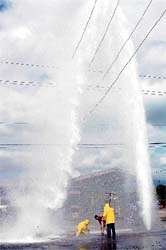Needle manufacturers, distillers and rolling-paper factory owners are some of Hawaii’s biggest fans. A new survey by the state Department of Health shows that the number of state residents needing treatment for drug and alcohol abuse is on the rise.
Needle manufacturers, distillers and rolling-paper factory owners are some of Hawaii’s biggest fans.
A new survey by the state Department of Health shows that the number of state residents needing treatment for drug and alcohol abuse is on the rise.
Residents needing treatment rose almost 5 percent between 1995 and 1998.
Elaine Wilson, chief of the department’s alcohol and drug abuse division, said the most abused substance in Hawai’i is still alcohol.
The latest survey shows that alcohol abusers in 1998 who sought out, or were mandated into treatment, rose from 57,000 to 67,000 in just three years.
The greatest increase in heavy alcohol abuse is among young females, according to Wilson.
An unfortunate first for the state is crystal methamphetamine use, which was about 20 percent higher than the national average in 1998.
In 1998, an estimated 8,100 adults needed treatment for ice, compared to 6,200 in 1995, Wilson said.
“I see a lot of it (meth use). It’s become the drug of choice for adolescents on Kaua’i. It’s apparently easily available and the kids like it because their parents don’t know they are on it,” said Dr. Gerald McKenna, director of Kauai’s Ke Ala Pono Recovery Centers.
Kaua’i County Prosecuting Attorney Mike Soong said meth use “is certainly on the increase on Kaua’i.”
“The unfortunate thing is it hasn’t peaked yet here,” Soong said. “I’ve been talking to some of the public defenders and prosecutors on Oahu recently, and they feel it has peaked there. People here don’t really have an awareness of how bad this drug is. They don’t know what the down side is.”
Soong claims methamphetamine use is behind at least 80 percent of the crime on Kaua’i.
“People think meth users are going to look like maniacs and be easy to spot,” although in the beginning stages, at least, “nothing could be further from the truth. But when they are on it for a long period of time, there can be unprovoked violence,” McKenna noted.
And more, according to Soong.
“Meth has been involved in so many hostage situations and murders” on Oahu, he said. “And if you’ve had a family member on it, you’d think twice about using it. There is story after story of straight-A students getting addicted and dropping off the face of the Earth. It is an evil drug that can just ruin your life.”
But meth addiction, especially caught early, can be treated, according to McKenna.
“We have groups (of teen users) that meet three times a week. And then we have a family program on Saturday,” McKenna said. “Kids whose parents get involved do the best (at quitting meth). But if parents are active, it isn’t particularly hard to get them off meth amphetamine.”
There are reasons teenage girls use the drug, in addition to the obvious one of getting high.
“Girls like it because it helps them to lose weight. A problem there is, we see girls with much older boyfriends” who eventually abuse them sexually, “saying, “You have to do this for me if you want to get the drugs,'” McKenna said.
Heroin use also increased statewide to more than 8,000 adults, from 2,660.
“There has always been heroin here during my 12 years on the island. It’s a stable group of people (using). They smoke it, don’t shoot it, and we only see them (in treatment) if the supply gets cut off. They don’t do well in treatment because they are able to use the drug and keep working,” McKenna noted.
Cocaine was the only illegal drug surveyed in which usage and treatment decreased radically for all ages, both genders and all ethnicities.
“I think methamphetamine has just taken over (from cocaine). It’s easier to tell if someone is on cocaine,” McKenna said.
Treatment for hallucinogens has increased four-fold in the 1995-1998 and heroin experimentation has tripled.
But marijuana still remains number one in the hearts and lungs of Hawaii’s drug users though with 5 percent of the population estimated to indulge on a regular basis.
And surprisingly, according to McKenna, marijuana is the toughest drug to wean people from.
“I think alcohol is the easiest (addiction) to treat. Methamphetamine is next and cocaine after that. Marijuana is the most difficult. They use it from day to night, they use it all the time. They can end up losing their families if they are stoned all the time. If they do quit, everything in their life seems distorted. Alcoholics feel better right away when they quit. But with (lifetime) marijuana users, nothing feels normal to them when they stop smoking. Everything feels distorted,” McKenna said.
McKenna said marijuana addicts need to hang in for about six months after quitting the drug before normality begins to reassert itself.
Honolulu County has the largest number of people seeking treatment and the Big Island had the greatest increase in total treatment needed, according to the state study.
The report also found more men abused substances and needed treatment than females. And teenage drug use is increasing statewide.
“Parents need to talk to their kids about drug use. This is not a place (in your kid’s life) to put your head in the sand,” McKenna concluded.
Staff writer Dennis Wilken can be reached at 245-3681 (ext. 252) and mailto:dwilken@pulitzer.net


